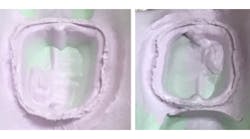Frustrated with air bubbles? Wasted impression material? Gingival retraction cord? This cordless impression system is for you.
I love making impressions for indirect restorations—always have. I am one of those dental “old souls” who find peace and tranquility when refining margins and placing gingival retraction cord. I have a system that has always worked for me, but I am always open to trying new impression materials. There are many impression materials that I enjoy using because my technique works for me.
I had the opportunity to try the Aquasil Ultra Cordless Impression System (Dentsply Sirona). It was given that name because the tip of the syringe is so small that it can force impression material into the gingival sulcus to capture an impression of the gingival margins without any gingival retraction cord (figure 1). Although I have to admit that I still love my gingival retraction cord and I am not willing to give it up completely, the Aquasil Ultra Cordless Impression System offers many advantages.
Figure 1: The tip of the Aquasil Cordless Impression System (left) is significantly smaller than a conventional syringe tip (right).
Easy setup
The Aquasil Ultra Cordless Impression System attaches to an air-driven handpiece connection on the bracket table. When it is not in use, it sits in the cradle in your bracket table. When it is in use, the setup is rotated; when the rheostat is pressed on the foot pedal, air will be driven into the handpiece to dispense the material through the syringe.
No air bubbles
How disappointing is it when you syringe impression material onto a tooth, and all is going well … and then you hear a pop of air come through your syringe? Despite many efforts to minimize air entrapment in my syringes, it still happens. With this impression system, a smooth, consistent flow of impression material is applied into the gingival sulcus or onto the crown preparation. The result is fewer voids.
Minimal wasted material
There are two cartridges that can be used in the syringe: one for single units and one for multiple units (figure 2). The amount of material in each cartridge is appropriate, not too little and not too much. I still reserve my conventional syringe for my full-arch impressions, but I can comfortably use the single-unit cartridge on two crown preparations and the multiple-unit cartridge for up to six teeth.
Figure 2: There are two cartridges for the Aquasil Ultra Cordless Impression System that are currently available: one for single units (1:30 setting time) and one for multiple units (2:30 setting time).
Exceptional for thin gingival tissue or conservative veneer preparations
Nothing is more frustrating than carefully impressing an anterior case and having the patient return with gingival recession. This is very common in patients who have thin gingival tissue or if too much pressure is applied to the gingival attachment gingival retraction cord is placed. In cases where maintaining the position of the gingival tissues is paramount, this will be my go-to system. The tip of the syringe can be carefully placed at or slightly below the gingival sulcus—without gingival retraction cord—and this material will easily capture the margins, without damaging the delicate adjacent gingival tissue.
Great for capturing small details
The combination of the small syringe tip and the varying speeds of the Aquasil Ultra Cordless Impression System is ideal for capturing the small details of our preparations and restorations. I like the option of preparing retentive grooves in my preparations when necessary, and I appreciate this system's ability to capture all of the details of my grooves (figure 3).
This system is especially useful for making impressions for small indirect restorations or for capturing information to pass along to dental laboratory technicians. I recently tried four anterior crowns on a patient, and I detected some small spaces just coronal to the interproximal contacts that I planned to ask my laboratory technician to modify. In addition to taking photographs of the areas, I used my Aquasil Ultra Cordless Impression System to capture the spaces in a pick-up impression.
Figure 3: Impression of a crown preparation. Note the details of the retention groove, the margins, and the details within the occlusal aspect of the preparation. With the Aquasil Ultra Cordless Impression System, gingival retraction cord is not necessary. A small (000) cord was placed for this crown preparation. Note that the impression material adequately captured the gingival sulcus, providing the laboratory technician with excess impression material to aid in identifying the margins while trimming dies.
Excellent physical properties
This material has the same excellent qualities that we have been accustomed to with Aquasil.
If you are still making traditional impressions and haven’t taken the intraoral scanner plunge, the Aquasil Ultra Cordless Impression System is an excellent technological advancement for indirect restorations.
Editor's note: This article first appeared in Pearls for Your Practice: The Product Navigator.Click here to subscribe. Click here to submit a products article for consideration.










